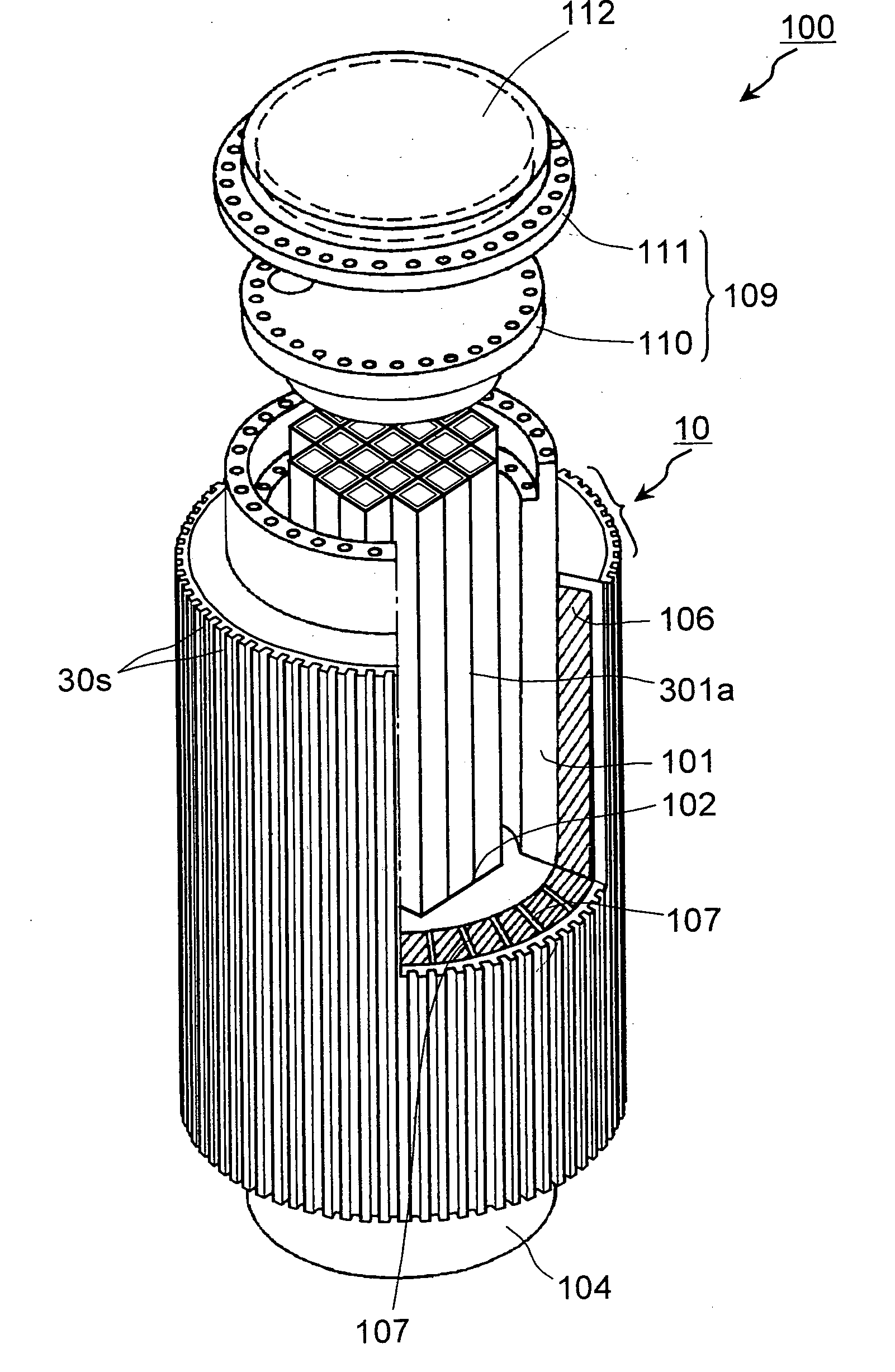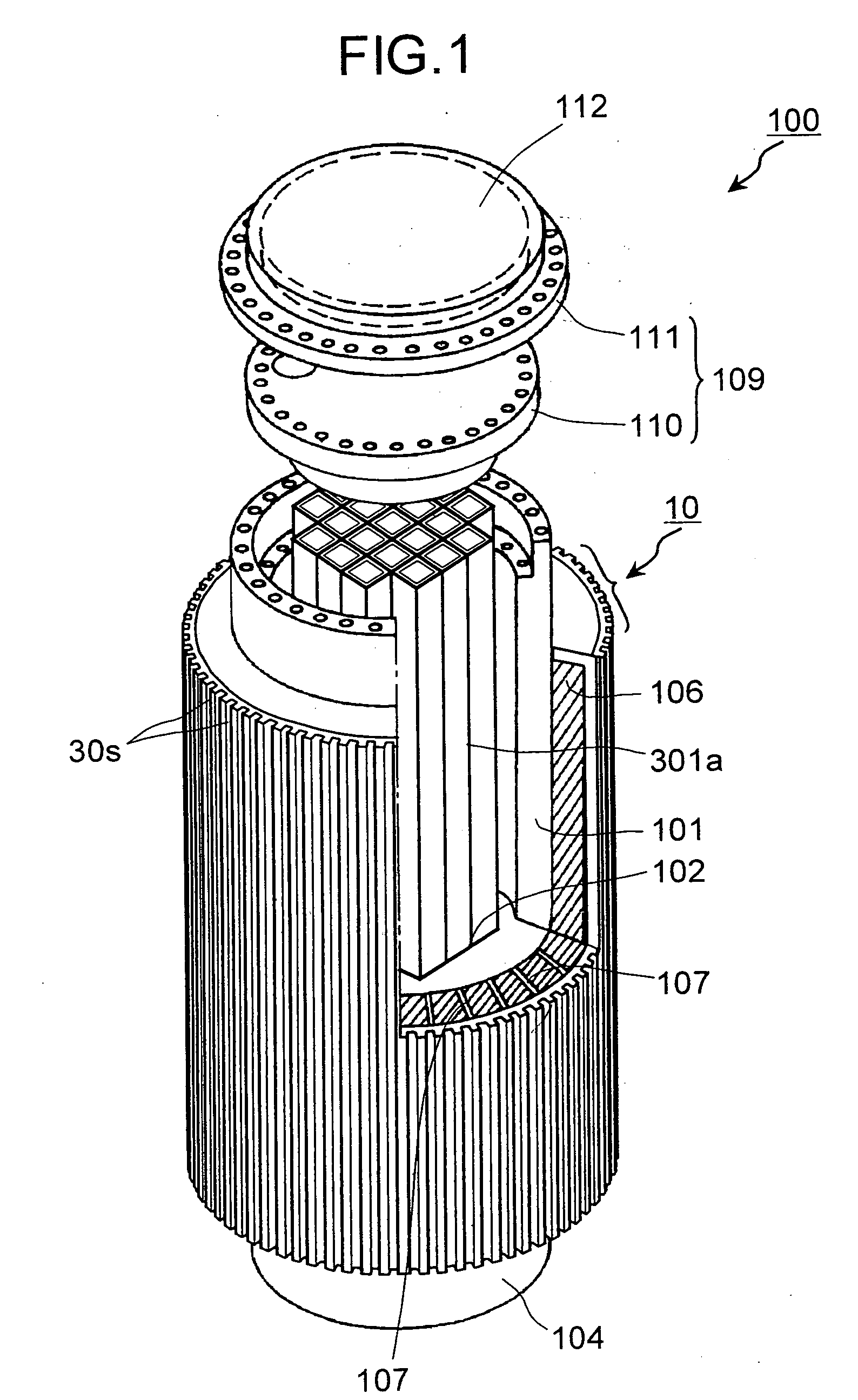Cask and method of producing the same
a production method and technology of a cask are applied in the field of cask and a production method, which can solve the problems of not clear if it can be realized, increase the cost of the manufacturing of the cask b>500/b>, etc., and achieve the effects of reducing the labor for forming the groove, reducing production time, and reducing production costs
- Summary
- Abstract
- Description
- Claims
- Application Information
AI Technical Summary
Benefits of technology
Problems solved by technology
Method used
Image
Examples
third modification example
(Third Modification Example)
[0212]FIGS. 30A to 30C are schematics of the outer casing of the cask according to a third modification example of the first embodiment. An outer casing 13 of this cask has a substantially similar configuration to that of the outer casing 10 of the cask according to the first embodiment, but is different in that the cross-sectional shape of at least one of a groove 33s and a radiating fin 33f, being a protrusion divided by the grooves 33s, is formed in a circular-arc shape. The configuration of other parts is the same as in the first embodiment, and the explanation thereof is omitted, and like reference signs designate like parts.
[0213] As shown in FIGS. 30A to 30C, a plurality of grooves 33s having the circular-arc cross section are formed on the radiating surface 105p side of the band-like member 105a constituting the outer casing 13. The radiating fins 33f are formed by the grooves 33s on the radiating surface 21p side of the band-like member 105a and...
sixth embodiment
[0236]FIGS. 40A and 40B are assembly diagrams of a cask according to a sixth embodiment of the present invention. FIGS. 41A to 41C are cross sections cut along line A-A in FIG. 40A. In this cask 400, the grooves 30s directed to the axial direction (Z direction in the figure) of the trunk body 101 in the cask 400 are formed on the outside of a unit 402 formed in a ring shape, which constitutes an outer casing 401, and the unit 402 is sequentially inserted in the axial direction of the trunk body 101, and welded. As shown in FIGS. 42, 40A and 40B, the grooves 30s directed to the circumferential direction of the trunk body 101 in the cask 400 may be formed on the outside of the unit 402 formed in a ring shape, which constitutes the outer casing 401, and the unit 402 may be sequentially inserted in the axial direction of the trunk body 101, and welded. Though not shown, as explained in the modification example of the first embodiment, grooves directed to the axial direction and grooves ...
seventh embodiment
[0246]FIGS. 46A to 46E are partial cross-sections of a part of an outer casing of a cask according to a seventh embodiment of the present invention. This cask has a feature in that radiating fins 550f for transferring the decay heat from the trunk body 101 to an outer casing 19 and the outer casing 19 are integrally formed, and the grooves 30s directed to the axial direction of the trunk body 101 are formed on a radiating surface 550p.
[0247] The outer casing 19 is formed by combining units 550 obtained by bending a plate member in an L shape in cross section. The grooves 30s directed to the axial direction of the trunk body 101 are formed on the radiating surface 550p side of the unit 550, and protrusions divided by the grooves 30s become the radiating fins 30f. The grooves 30s may be provided toward the circumferential direction of the trunk body 101, or may be provided toward both the axial direction and the circumferential direction of the trunk body 101.
[0248] One end 550t1 of...
PUM
 Login to View More
Login to View More Abstract
Description
Claims
Application Information
 Login to View More
Login to View More - R&D
- Intellectual Property
- Life Sciences
- Materials
- Tech Scout
- Unparalleled Data Quality
- Higher Quality Content
- 60% Fewer Hallucinations
Browse by: Latest US Patents, China's latest patents, Technical Efficacy Thesaurus, Application Domain, Technology Topic, Popular Technical Reports.
© 2025 PatSnap. All rights reserved.Legal|Privacy policy|Modern Slavery Act Transparency Statement|Sitemap|About US| Contact US: help@patsnap.com



